
The Yankees pitching staff appears to be this roster’s David to their lineup’s Goliath, as many in the industry believe the starting rotation can prevent them from reaching their lofty expectations.
While the Yankees have an offense that looks like it can break records, their pitching staff is flying under-the-radar as it did in 2017. It’s easy to forget that the Yankees starting rotation finished 2017 with the 3rd lowest ERA in the AL, despite the question marks that dominated headlines prior to the start of 2017.
After the acquisition of Giancarlo Stanton, again much of the criticism about the team this off-season has been about their starting rotation, especially after their failed pursuit of Gerrit Cole. The criticism is despite them bringing back mostly the same rotation that excelled in 2017, and now with Sonny Gray replacing Michael Pineda, perhaps an even better one.
But how will the Yankees meet their championship-or-bust expectations in 2018? They will undoubtedly be led by their fearsome bullpen, one that led MLB.com’s Bryan Hoch to claim they could be historic. And it’s also the reason why I believe the Yankees may have the best pitching staff in baseball that can lead them to a World Series title.
Obviously, in order to get to the World Series, first you need to make the playoffs, which seems like a pretty safe bet given their roster projections. Now, once in the playoffs, this is when the Yankees pitching staff seems to shine above the other projected contenders.
